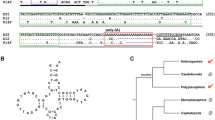Abstract.
Four tRNA-related SINE families were isolated from the genome of the shrew Sorex araneus (SOR element), mole Mogera robusta (TAL element), and hedgehog Mesechinus dauuricus (ERI-1 and ERI-2 elements). Each of these SINEs families is specific for a single Insectivora family: SOR, for Soricidae (shrews); TAL, for Talpidae (moles and desmans); ERI-1 and ERI-2, for Erinaceidae (hedgehogs). There is a long polypyrimidine region (TC-motif) in TAL, ERI-1, and ERI-2 elements located immediately upstream of an A-rich tail with polyadenylation signals (AATAAA) and an RNA polymerase III terminator (T4\N6 or TCT3\N4). Ten out of 14 analyzed mammalian tRNA-related SINE families have an A-rich tail similar to that of TAL, ERI-1, and ERI-2 elements. These elements were assigned to class T+. The other four SINEs including SOR element have no polyadenylation signal and transcription terminator in their A-rich tail and were assigned to class T−. Class T+ SINEs occur only in mammals, and most of them have a long polypyrimidine region. Possible models of retroposition of class T+ and T− SINEs are discussed.
Similar content being viewed by others
Author information
Authors and Affiliations
Additional information
Received: 12 December 2000 / Accepted: 31 May 2001
Rights and permissions
About this article
Cite this article
Borodulina, O., Kramerov, D. Short interspersed elements (SINEs) from insectivores. Two classes of mammalian SINEs distinguished by A-rich tail structure. Mammalian Genome 12, 779–786 (2001). https://doi.org/10.1007/s003350020029
Published:
Issue Date:
DOI: https://doi.org/10.1007/s003350020029




